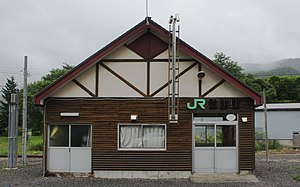railroad.wikisort.org - Station
Shikaribetsu Station (然別駅, Shikaribetsu-eki) is a train station in Niki, Yoichi District, Hokkaidō, Japan. The station is numbered S20.[1]
Shikaribetsu Station 然別駅 | |
|---|---|
 Station building, August 2017 | |
| General information | |
| Location | Niki, Hokkaido, Hokkaido Japan |
| Coordinates | 43°07′31″N 140°44′13″E |
| Operated by | |
| Line(s) | ■ Hakodate Main Line |
| Distance | 224.1 km from Hakodate |
| Platforms | 2 side platforms |
| Tracks | 2 |
| Other information | |
| Status | Unstaffed |
| Station code | S20 |
| History | |
| Opened | 10 December 1902 |
| Passengers | |
| FY2013 | 14 daily |
Lines
Shikaribetsu Station is served by the Hakodate Main Line and is 224.1 km from the start of the line at Hakodate.[2]
Station layout
The station has two ground-level opposed side platforms serving two tracks. Kitaca is not available. The station is unattended.[citation needed]
Adjacent stations
| « | Service | » | ||
|---|---|---|---|---|
| Hakodate Main Line | ||||
| Ginzan (S21) | Rapid | Niki (S19) | ||
| Ginzan (S21) | Local | Niki (S19) | ||
History
Shikaribetsu Station opened on 12 December 1902 when the private Hokkaido Railway established a track between it and Ranshima. By 28 June 1903, the track had been extended north from Ranshima to Otaru Chūō (now Otaru). By 19 Oct 1904, link ups to the track south of Shikaribetsu had allowed through traffic all the way to Hakodate. After the Hokkaido Railway was nationalized on 1 July 1907, Japanese Government Railways (JGR) took over control of the station. On 12 October 1909 the station became part of the Hakodate Main Line. On 1 April 1987, with the privatization of Japanese National Railways (JNR), the successor of JGR, the station came under the control of JR Hokkaido.[2][3] From 1 October 2007, station numbering was introduced on JR Hokkaido lines, with Shikaribetsu Station becoming "S20".[4]
References
- "JR Hokkaido Route Map" (PDF). JR Hokkaido. Retrieved 21 February 2018.
- Ishino, Tetsu; et al., eds. (1998). 停車場変遷大事典 国鉄・JR編 [Station Transition Directory – JNR/JR] (in Japanese). Vol. II. Tokyo: JTB Corporation. p. 812. ISBN 4-533-02980-9.
- Ishino, Tetsu; et al., eds. (1998). 停車場変遷大事典 国鉄・JR編 [Station Transition Directory – JNR/JR] (in Japanese). Vol. I. Tokyo: JTB Corporation. p. 240. ISBN 4-533-02980-9.
- 駅番号表示(駅ナンバリング)を実施します [Station number to be introduced] (PDF). News release (in Japanese). Hokkaido Railway Company. 12 September 2007. Retrieved 30 July 2015.
Другой контент может иметь иную лицензию. Перед использованием материалов сайта WikiSort.org внимательно изучите правила лицензирования конкретных элементов наполнения сайта.
WikiSort.org - проект по пересортировке и дополнению контента Википедии